Linden D., Reddy T.B. (eds.) Handbook of batteries
Подождите немного. Документ загружается.


23.36 CHAPTER TWENTY-THREE
The cranking ability of an SLI battery is directly proportional to the geometric area of
plate surface, with the proportionality factor typically 0.155 to 0.186 cold-crank Amperes
(CCA) at
⫺17.8⬚C(0⬚F) per square centimeter of positive-plate surface. Cranking perform-
ance is generally limited by the positive plate at higher temperatures (
⬎18⬚C) and by the
negative plate at lower temperatures (
⬍5⬚C). The ratio of positive surface to negative surface
is fixed by design. To maximize the cranking capacity, SLI battery designs emphasize grids
with minimum electrical resistance (using a variety of radial and expanded grid designs),
thin plates, and a higher concentration of electrolyte than motive-power or stationary batter-
ies.
Usually an ‘‘outside-negative’’ (n
⫹ 1 negative plates interspersed with 2n separators and
n positive plates) design is used. However, in order to balance the cranking rating with the
requirement or electrical load, as well as to facilitate automatic assembly, SLI batteries with
an even number of plates, or ‘‘outside-positive’’ designs, are widely produced in the United
States.
A major advance is the maintenance-free SLI battery, which has several characteristics
that distinguish it from the conventional battery. It requires no addition of water during its
life, it has significantly improved capacity retention during storage, and it has minimal ter-
minal corrosion. The construction of a typical maintenance-free SLI battery was illustrated
in Fig. 23.8. This type of battery relies mainly on charge control to prevent electrolysis of
water and dry-out as compared to the small sealed consumer designs which rely on oxygen
recombination (see Chap. 24).
The SLI maintenance-free battery has a large acid reservoir, made possibly by the use of
smaller plates and placement of the element directly on the bottom of the container, elimi-
nating the sludge space. The positive plates are usually enveloped in a microporous separator
that prevents active material from falling to the bottom of the container and creating a short
circuit. An important feature of the maintenance-free battery is the use of nonantimonial
(such as calcium-lead) or low-antimonial lead grids. The use of these grids reduces the
overcharge current significantly, reducing the rate at which water is lost during overcharge,
as well as improving the stand characteristics (see Sec. 23.7). The use of the expanded grid,
produced from wrought lead-calcium strip, is also shown in the figure. Most SLI batteries,
so called hybrid, are built using lead-calcium-tin grids for the negative and low-antimony
lead grids for the positive electrode.
Another refinement of the SLI battery is illustrated in Fig. 23.16. In this design the plates
are approximately one-fifth the width of conventional SLI battery plates and are inserted
parallel, rather than perpendicular, to the length of the battery case. This design reduces the
internal impedance of the cell and gives very high CCA ratings.
Heavy-duty SLI batteries for trucks, buses, and construction equipment are designed sim-
ilar to the passenger vehicle SLI batteries but use heavier and thicker plates with high-density
paste, premium separators often with glass mats, anchor-bonding of the element to the bottom
of the case, rubber cases, and other such features to enhance longer life. This is necessary
to provide maximum mechanical strength for the physically large (up to 530 by 285 mm)
case dimensions. Because the thick plates provide less cranking current than the thinner
plates (since fewer can be included in a cell of a given size), series or series-parallel con-
nections of batteries are used. Typically, the 12-V monoblocks are connected in series for
cranking at 24 V and in parallel for running and recharging at 12 V. A few sizes of main-
tenance-free heavy-duty batteries have also been produced.
SLI-type batteries are also used on motorcycles and boats. Batteries for recreational ma-
rine use generally have thicker plates (to give more capacity) and higher-density paste. They
have the same Battery Council International type designations as automotive batteries. See
Sec. 4.10 for a listing of BCI battery types. Marine batteries are also manufactured in four-
cell 8-V monoblocs.
Aircraft use SLI-type batteries with special spill-proof vent caps which preclude loss of
electrolyte during flight.
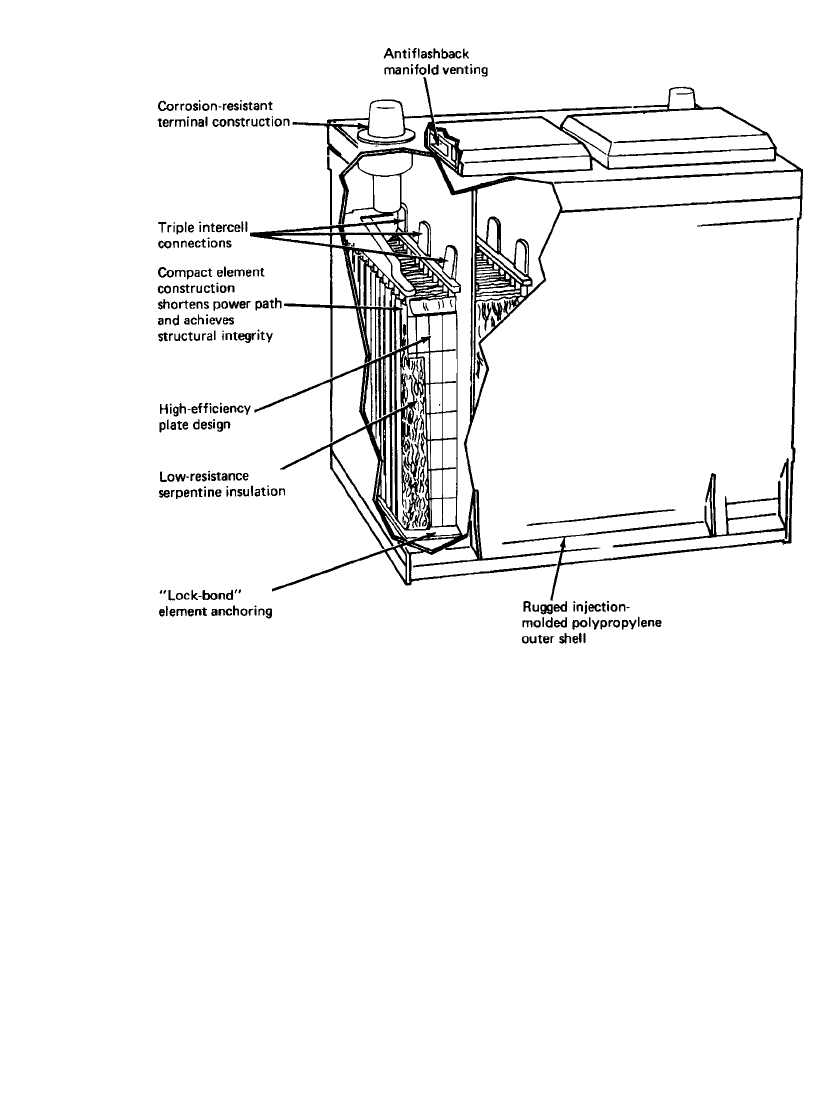
LEAD-ACID BATTERIES 23.37
FIGURE 23.16 Cathanode lead-acid SLI battery.
23.4.3 Performance Characteristics
Discharge Performance. Discharge curves, showing the discharge profile of SLI-type bat-
teries at several constant-current discharge rates, are presented in Fig. 23.17. The typical
final or end voltages at these discharge rates are also shown. Higher service capacity is
obtained at the lower discharge rates. At the higher discharge rates, the electrolyte in the
pore structure of the plates becomes depleted and the electrolyte cannot diffuse rapidly
enough to maintain the cell voltage. Intermittent discharge, which allows time for the elec-
trolyte to recirculate, or forced circulation of the electrolyte will improve high-rate perform-
ance. In general the lead-acid cell may be discharged without harm at any rate of current it
will deliver, but the discharge should not be continued beyond the point where the cell
approaches exhaustion or where the voltage falls below a useful value.

23.38 CHAPTER TWENTY-THREE
FIGURE 23.17 Discharge curves of lead-acid SLI batteries. (a) At various hourly rates and
25⬚C. (b) At various high rates and ⫺17.8⬚C. Battery rated at 70 Ah, 20-h rate at 25⬚C.
Effect of Temperature on Performance. Figure 23.18(a) shows typical discharge curves
for a lead-acid single-cell battery at several discharge temperatures. Fig. 23.18(b) shows the
discharge characteristics of a 12 V, 60 Ah battery when discharged at 340 A at temperatures
from
⫺30 to 25⬚C. Higher discharge voltages and capacities are obtained at the higher
temperatures and lower discharge rates.
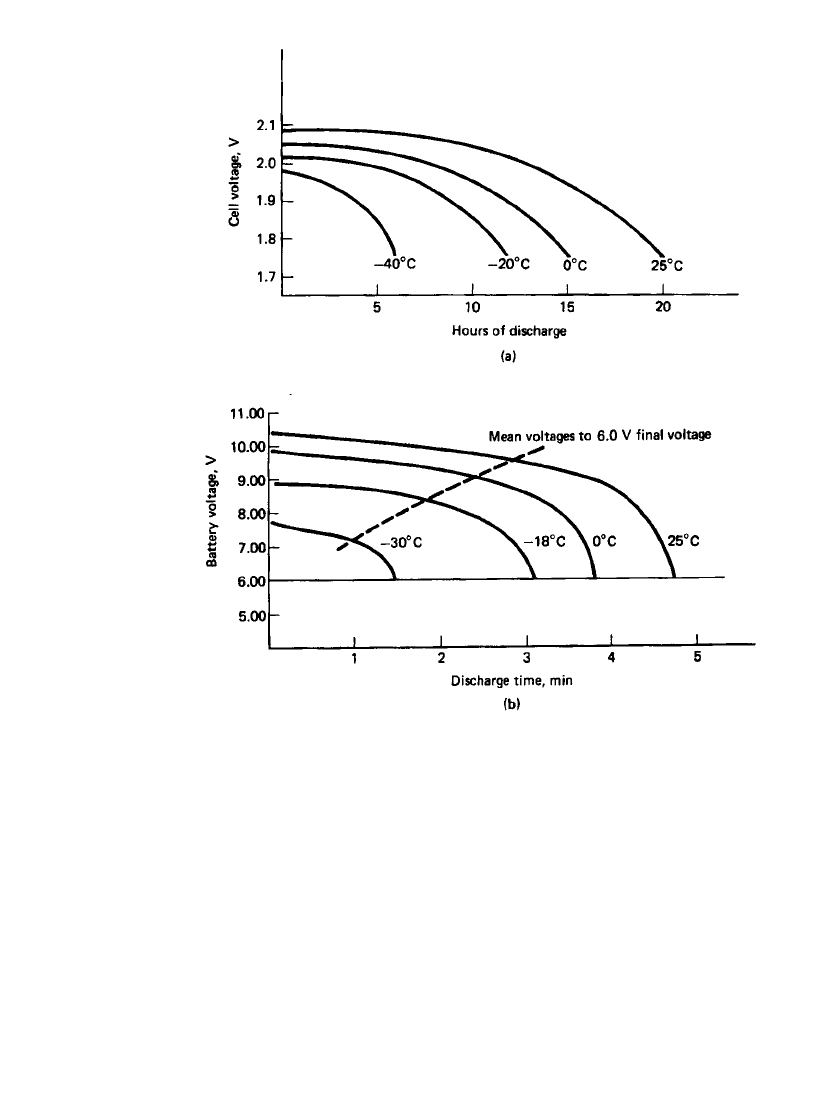
LEAD-ACID BATTERIES 23.39
FIGURE 23.18 Discharge curves of lead-acid SLI batteries at various tempera-
tures. (a)AtC / 20 rate. (b) At 340 A. 12-V battery, nominal capacity 60 Ah, 20-h
rate at 25⬚C.
The effect of discharge rate and temperature on the capacity of the lead-acid battery is
summarized in Fig. 23.19, which shows the percentage of the 20-h rate capacity delivered
under different discharge conditions. Although the battery will operate over a wide temper-
ature range, continuous operation at high temperatures may reduce life as a result of an
increase in the rate of corrosion (see Sec. 23.8.1).
The performance of the lead-acid SLI-type cell at different temperatures and loads is
given in another form in Fig. 23.20. The logarithm of the current drain is plotted against the
logarithm of the service hours, in accordance with Peukert’s relationship (Chap. 3, Sec.
3.2.6). The linear relationship is maintained over a wide range, with divergences appearing
on the high-rate and low-temperature discharges. In this figure, the data have been normalized
to unit cell weight (kilograms) and unit cell volume (liters). Figure 23.20 can be used to
approximate the performance of various size cells over the operating conditions shown or to
determine the size and weight of a battery to meet a particular service requirement.
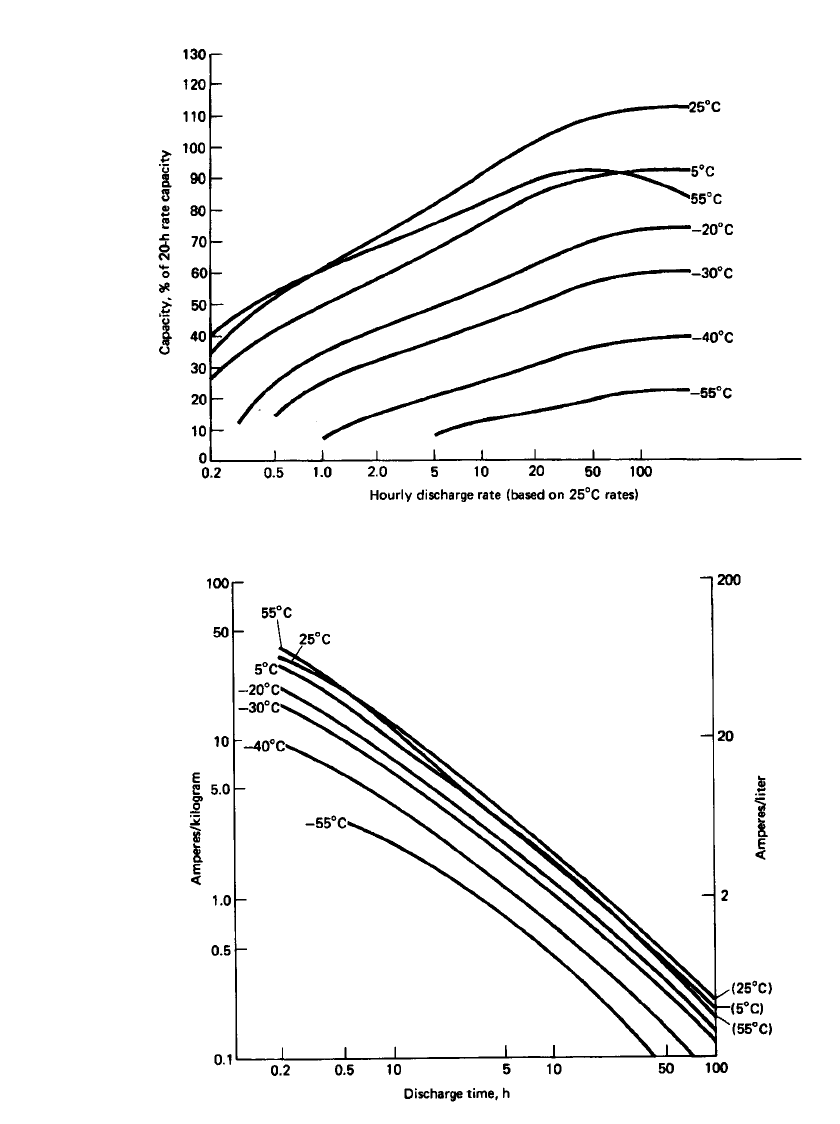
23.40 CHAPTER TWENTY-THREE
FIGURE 23.19 Performance of lead-acid SLI batteries at various temperatures and discharge
rates to 1.75-V per cell end voltage.
FIGURE 23.20 Service life of lead-acid SLI battery to 1.75-V end voltage per cell.
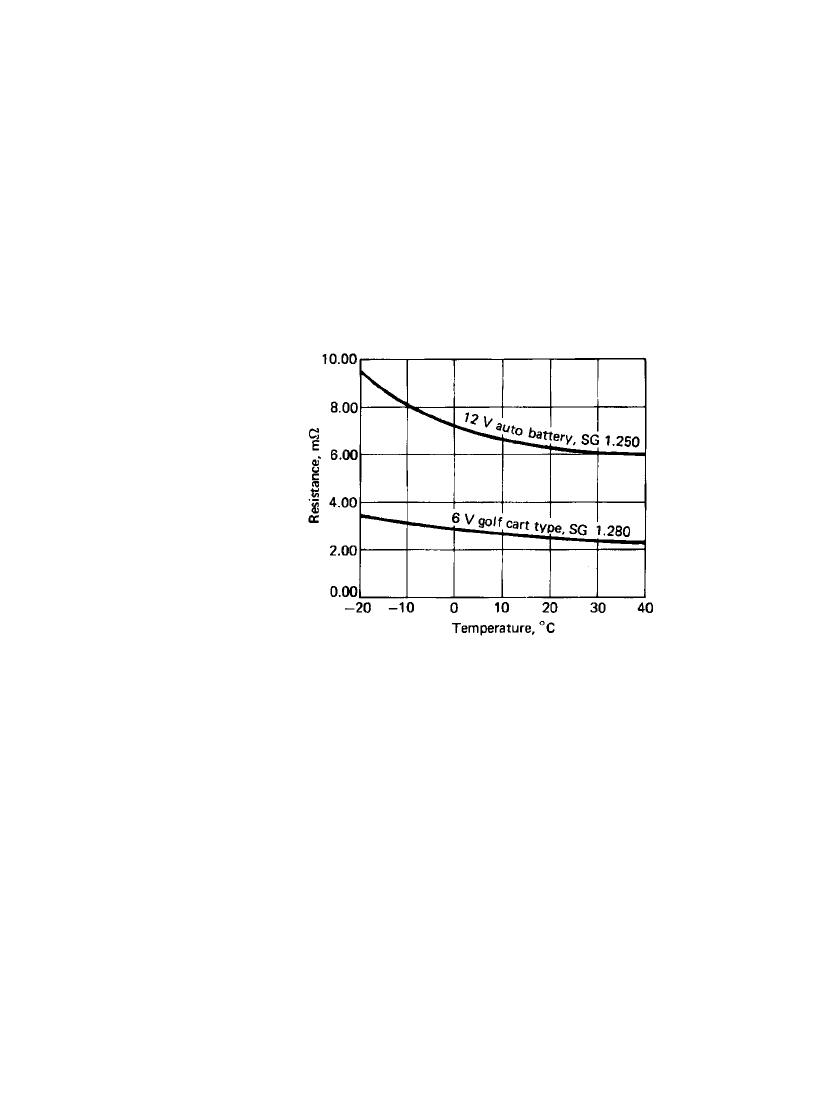
LEAD-ACID BATTERIES 23.41
Internal Impedance. The high current requirement for engine cranking demands that the
batteries be designed with low resistance; for example, that conductors have large cross
sections and minimal lengths, that separators have maximum porosity and minimum backweb
thickness, and that the electrolyte be in the range of low resistance. The relationship between
plate surface area and CCA suggests the involvement of the electrochemical double layer of
the porous active materials. Low frequencies are generally necessary to evaluate the capac-
itive reactance component of battery impedance—strictly the resistance impedance compo-
nents can be evaluated by Ohm’s law by determining the voltage difference at two levels of
discharge current. The resistance of a lead-acid battery increases during a discharge almost
linearly with the decrease of the specific gravity of the electrolyte. The difference in resis-
tance between full charge and discharge is in the order of 40%. The effect of temperature
on the resistance of the battery is shown in Fig. 23.21; the battery resistance increases by
about 50% between 30 and
⫺18⬚C.
FIGURE 23.21 Comparison of lead-acid battery
designs. Effect of temperature on battery resistance.
Self-Discharge. A lead-acid battery loses capacity during open-circuit stand (self-
discharge). This loss is more severe with batteries which use antimonial lead grid alloys in
the positive plates. A comparison of the open-circuit stand loss of conventional antimonial
lead (
⬎4% Sb), low antimonial lead (⬍3% Sb), and nonantimonial lead grids is shown in
Fig. 23.6. This loss is most easily detected by a drop in the terminal voltage of the battery
and/ or the specific gravity. The sulfuric acid reacts, primarily on the surface of the negative
plate, in small local self-discharge ‘‘cells’’ where antimony and lead are in contact, becoming
a small particle of lead sulfate. In batteries using calcium-lead nonantimonial lead negative
and antimonial lead positive grids, self-discharge loss is minimized until antimony diffuses
to the negative. This is especially true for the low-antimonial alloy positives.
Life and Failure Modes. The life of SLI batteries is affected by the design, the processing,
and the operational environment of the battery. Because of the automated assembly methods
used today, SLI batteries are fairly consistent in life under ideal operating conditions, but
the wide variety of operating conditions tends to spread the failure distribution. Warranty
coverage for a failed battery is often more dependent on marketing strategy than on the
statistical expectations of the failure rate.
SLI battery design, materials, and operation have changed markedly in the past two dec-
ades; life and failure mode distribution have also changed. In Fig. 23.22a the average age
of failed batteries is plotted. Possible explanations for the shorter life in 1982 may be a
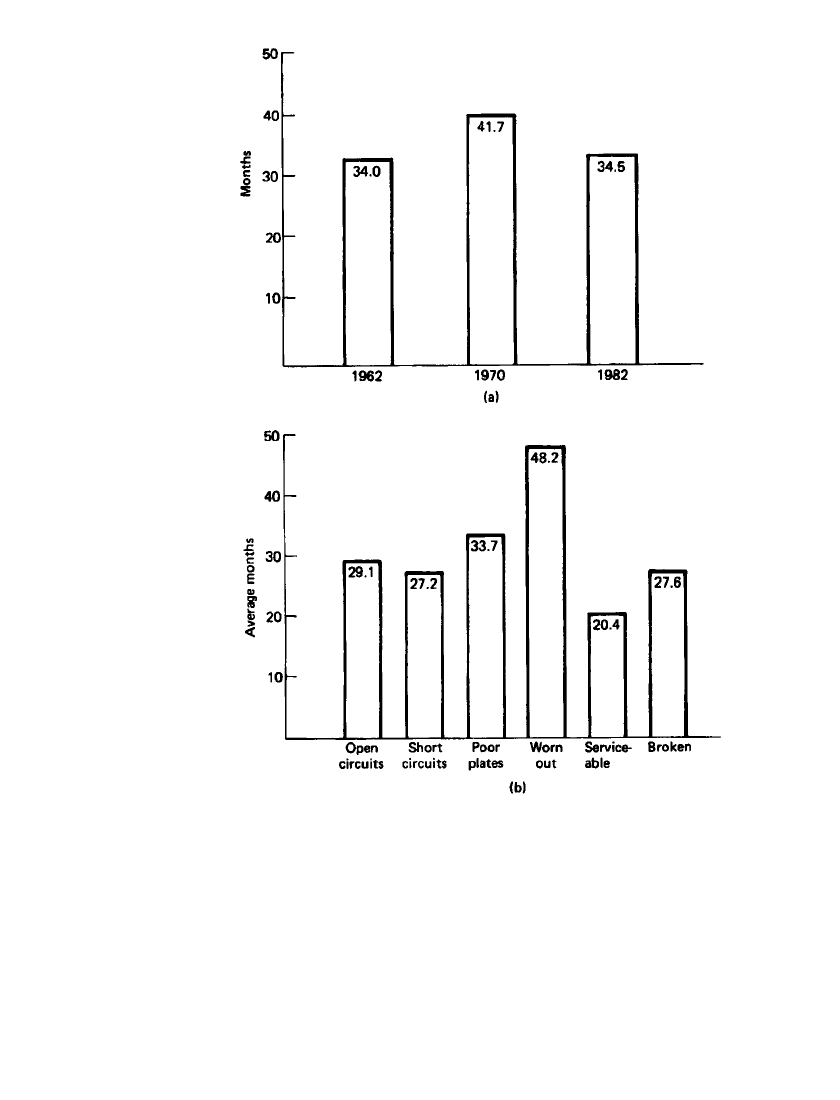
23.42 CHAPTER TWENTY-THREE
FIGURE 23.22 Failure modes of SLI batteries. (a) Average age of re-
turned batteries. (b) Failure mode of returned batteries. (From Amistadl.
4
)
reduction in battery size and more demanding performance requirements. These averages
include taxis, police cars, and other heavy-duty users, which account for the relatively low
age for failed batteries. Figure 23.22b shows the failure modes for these batteries, which are
described in more detail in Table 23.13. A higher incidence of short-circuited batteries used
in warmer climates suggests that grid corrosion is still a major failure mode. The ‘‘worn-
out’’ category includes low electrolyte level, and it should be noted that many maintenance-
free SLI batteries are sealed so that water, lost to evaporation and electrolysis, cannot be
replaced.
SLI batteries are not designed for deep-cycling service, and very short lives are generally
obtained with such operation. The deep-cycling capability of SLI batteries is covered in Sec.
23.5.2.

LEAD-ACID BATTERIES 23.43
TABLE 23.13 Summary of Failure Modes of Lead-Acid SLI
Batteries
1. Open circuits 4. Worn out
a. Terminal a. Worn out
b. Cell to terminal b. Undercharge
c. Cell to cell c. Low level (electrolyte)
d. Broken straps d. Terminal corrosion
e. Plates off e. Underformed
2. Short circuits 5. Serviceable
a. Plate to strap a. Serviceable
b. Plate to plate (plate fault) b. Discharged only
c. Plate to plate (separator fault) 6. Broken
d. Plate to plate (sediment /moss) a. Broken container
e. Vibration short circuit
3. Poor plates
a. Overcharge/overheat
b. Grid corrosion
c. Paste adhesion
d. Paste sulfation
e. Paste undeformed
b. Broken cover
c. Damaged terminal
d. Internal damage
e. Other
FIGURE 23.23 Correction factor for calculating cold-cranking Ampere (CCA) rating.
Standard Tests for Rating SLI Batteries. Several standard tests have been devised to eval-
uate and rate the performance of SLI batteries under conditions simulating the major re-
quirements of their applications. The cold-cranking Amperes (CCA) test evaluates the ca-
pability of the battery to deliver power to crank an engine at cold temperatures. The
cranking-test rating is the current that a fully charged battery can deliver at
⫺17.8⬚C for
30 s to a voltage of 1.2 V per cell. If the measured voltage is above or below this value at
30 s, the CCA value can be calculated by multiplying the discharge current by the correction
factor shown in Fig. 23.23. Figure 23.17b illustrates the performance of a 70-Ah cell with
a CCA rating of 550 A.

23.44 CHAPTER TWENTY-THREE
Reserve capacity is measured in a test of the battery’s ability to provide power for lights,
ignition, and the auxiliaries. The reserve capacity is defined as the number of minutes a fully
charged battery can maintain a current of 25 A to 1.75 V per cell at 25
⬚C.
Other SLI tests are included in the SAE battery test standard J 537 on charge rate ac-
ceptance, overcharge life, and vibration resistance. A standard SLI life test is specified in
SAE J240A. This test consists of a shallow discharge at 25 A followed by a brief charge at
voltage and current limits for 10 min.
23.4.4 Cell and Battery Types and Sizes
SLI battery sizes have been standardized by both the automotive industry through the Society
of Automotive Engineers (SAE), Warrendale, Pa., and the battery industry through the Bat-
tery Council International (BCI), Chicago.
21
The BCI nomenclature follows the standards
adopted by its predecessor, the American Association of Battery Manufacturers (AABM).
The latest standards are published annually by the Battery Council International (BCI).
21,22
Internationally, standardization is handled by the International Electrotechnical Commission
(IEC). More detailed information on these standards is found in Chapter 4, Sec. 4.10 and
Table 4.10.
23.5 DEEP-CYCLE AND TRACTION BATTERIES: CONSTRUCTION
AND PERFORMANCE
23.5.1 Construction
The prime requirement for deep-cycling batteries for traction applications is maximum cycle
life, then, if possible, high energy density and low cost. In an electric forklift application,
in fact, light weight may not be advantageous because the battery’s weight usually is needed
to counterbalance the payload. The life of these batteries is improved by the use of thick
plates with high paste density, usually a high-temperature and high-humidity cure, low elec-
trolyte density formation, premium separators, and one or more layers of glass fiber matting
(to retain the active material in the positive plates). The major modes of failure are disin-
tegration of the PbO
2
positive active mass and corrosion of the positive grids. The deep-
cycling battery is usually designed to be capacity-limited when new by the amount of elec-
trolyte and not by the material in the plates. This serves to protect the plates and maximize
their life. Both negatives and positives are degraded during use, but at end of life, battery
capacity is generally limited by the positive plate. Battery failure, for cycle life rating pur-
poses, is considered to occur when the battery will no longer produce 60–80% of its initial
or rated discharge capacity.
A typical traction battery, using flat-pasted plates, is shown in Fig. 23.24. Cells are always
made with an outside-negative design (e.g., n positive plates, n
⫹ 1 negative plates). Deep-
cycling traction batteries are built as an assemblage of individual cells. If the battery’s per-
formance is limited by a catastrophic failure of one (or a few) cell(s), then those cells can
be repaired or replaced in a cost-effective manner. Power requirements vary widely with the
load, distance traveled, and lifting or climbing requirements. Battery sizes are determined
by the forklift truck manufacturer and can be ‘‘calibrated’’ in the actual application by the
use of an Ampere-hour meter. A rough indication of the suitability of a traction battery for
an application is the change in the specific gravity of the electrolyte during use. A larger
battery size (or battery replacement or repair) is indicated when full operation cannot be
achieved.

LEAD-ACID BATTERIES 23.45
FIGURE 23.24 Flat-pasted-plate lead-acid traction battery. (Courtesy of C&D Technolo-
gies.)
Although the flat-pasted (Faure) positive plate is typical for deep-cycling batteries in the
United States, some cycling batteries in the United States and most cycling batteries in the
rest of the world are built with tubular or gauntlet-type positives (Fig. 23.25). The tubular
construction minimizes both grid corrosion and shedding, and long life is characteristic of
these designs, but at a higher initial cost. Flat-pasted negative plates are used in conjunction
with these positives and the cells are of the outside-negative design.
